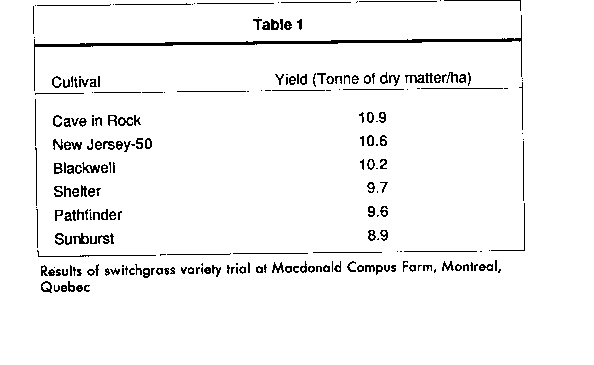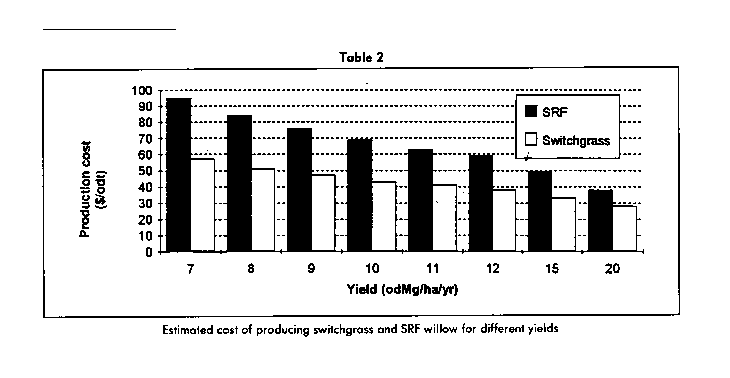
Sustainable Farming Index | Virtual Library | Magazine Rack
Search
| Ecological Solutions Roundtable
Research Update
Biomass: An emerging industry for agriculture
by Patrick Girouard
According to biomass research done by REAP-Canada, switchgrass and short rotation forestry windbreaks are currently the two most promising energy feedstocks for potential future profitability in the agricultural industry.
In the spring of 1992, REAP-Canada initiated a three-year on-farm biomass research program in Ontario and Quebec, funded by Natural Resources Canada and Agriculture Canada. The goal of the program was to identify and challenge current production barriers preventing the development of biomass production systems.
The project is presently in the process of assessing the potential of short-rotation forestry (SRF) systems in both monoculture and shelterbelt applications, as well as appraising the viability of switchgrass, a warm season grass.
Productivity
Switchgrass yield data was obtained for the first time in the fall of 1993. The best yielding cultivar was Cave-in-Rock (10.9 oven dried tonnes per hectare - odt/ha), followed closely by the New Jersey 50 and Blackwell, (see Table 1).
Table 1
Switchgrass variety trial at Macdonald Campus Farm, Montreal, Quebec

Yield data was obtained from a variety trial at the Macdonald Campus farm of McGill University near Montreal, Quebec. The stand was two years old and managed under a one-cut system. More yield data is expected to be obtained from larger plots this fall.
Based on the Quebec results, and what is being obtained from trials in the Northern United States, the switchgrass yield ranges from present cultivars for Quebec and Ontario are expected to be between 8 and 12 odt/ha.
As for SRF, the trees established in 1992 still need two additional years of growth before being harvested. Nevertheless, a literature review of yields obtained in large, unirrigated, experimental sites in Europe and North America leads REAP-Canada to believe that SRF monoculture plantations will likely not produce more than 7 to 11 odt/ha per year. This is below the required yields for economic viability as an energy feedstock - 15 to 23 odt/ha/yr.
Production costs
The estimated cost of growing switchgrass and SRF willow in monoculture plantations is presented in Table 2.
Table 2
Estimated cost of producing switchgrass and SRF willow for different yields

For the projected yield range in Central Canada, biomass can be produced for between $38.00 - $51.00/odt for switchgrass and $63.00 - $95.00/odt for SRF monoculture plantations. These figures include a return for use of the farmer's land, labour and management, and includes cash and non-cash costs.
Based on these production cost estimates, switchgrass is on average 37% cheaper to grow than SRF willow biomass in monoculture, on an equivalent yield basis. Nonetheless, this does not necessarily mean SRF should be completely discarded for energy production. Rather, it has to be targeted towards energy and non-energy markets that can afford to pay higher market prices.
The attractiveness of biomass for potential markets are for example:
a Alcohol fuel production: switchgrass has the best potential for this market, due to lower production costs. At present, an unsubsidized industry would need to pay no more than $30.00/odt for biomass feedstock for the industry to be profitable. With improvement in production and processing economics, switchgrass has the potential to become economically efficient in the near future
b Electricity generation: Based on present information, it does not appear to be profitable to build a large-scale electrical generating plant using SRF willow or switchgrass biomass as a feedstock in replacement of coal (in Central Canada). However, if reductions in carbon dioxide emissions were credited to the use of biomass there would be an increased potential for profits to be generated in this area. Purely on a cost basis, switchgrass would be the best alternative for the electricity generation market.
c Heat production: Both
crops seem equally promising for the heat production market.
Although densification might be necessary for herbaceous biomass,
the pm= €=